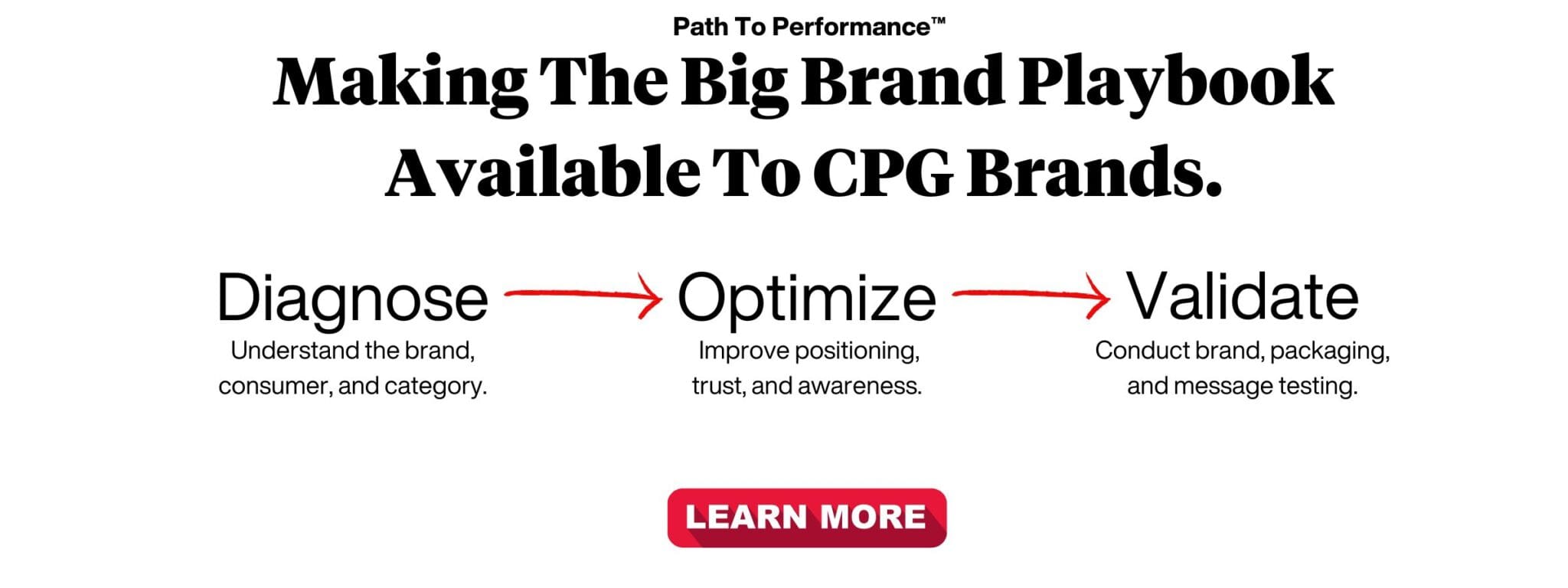How do you ensure continuous growth for your FMCG brand? One way is to create an effective strategy that strengthens and expands your brand footprint. When both depth and reach evolve harmoniously; companies see consistent, scalable profitability over time.
What is a Brand Footprint?
A brand footprint is how a company is represented and recognized in the market. The brand footprint includes elements such as the brand image and identity. The brand’s footprint encompasses elements such as
- Name
- Logo
- Tagline
- Color scheme
- Typography
- Messaging
- Packaging
- Advertising
- Website
- Social media accounts
- Customer service
- Overall reputation
As you can see, the brand footprint is all-encompassing rather than speaking to one isolated metric. We determine the total impact of the brand footprint by looking at everything from its moat, which is how a brand differentiates, to its trust-building ability and expanding customer loyalty.
The Three Aspects Of The Brand Footprint
The list of elements can be overwhelming, so let’s categorize them into three distinct divisions of consumer perception.
Brand Attributes
How do consumers view a brand? What is their tone of voice, brand archetype, and brand personality? Brand attributes are essential for every product category, especially commodity categories such as bottled water.
Brand Culture
In previous decades brands could get away with terrible cultures, but with the consumer’s ability to step into the company’s shoes, culture plays a vital role in the brand’s footprint. In today’s culture, brands must consider how they connect to consumer interests in everything from style to inclusivity. Every company’s decision should keep the brand culture in mind, as it will directly affect purchasing behavior.
Brand Identity
Here is where you get down to the nitty-gritty. Brand identity must be cohesive, consistent, and consumer-centric to strengthen your footprint. Lacking a solid brand identity is why many fail to become the chosen brand and hit a wall with their consumer reach point. A strong brand identity is critical in channel and household penetration.
Brand Footprint Case Study
While there is an emerging category of hipsters purchasing $7.00 fair trade and sustainably grown chocolate, most premium chocolate consumers are looking for a great-tasting luxury bar. Companies like Lindt’s Chocolate have built their brand footprint around luxury, quality, and indulgence.
Distinctive imagery with the proper color scheme and font suggests that Lindt’s is more elegant and sophisticated than the competition. Whether true or not, the messaging indicates that the brand only uses the best ingredients and follows the traditional Swiss chocolate-making process.
Lindt now hopes to leverage their brand footprint into the non-dairy/plant-based chocolate category. Will it work? Time will tell but we do scratch our heads at their choice of messaging variation (or lack thereof) on the front of pack.
What Lindt can do to push its brand footprint further is to focus on creating a forward-facing culture. While they may not need to showcase their “vibe,” the brand can achieve better household penetration by bringing consumers into the chocolate-making process. Telling your brand story is one of the consumer reach points established brands should take advantage of but fail to execute effectively.

How to Build a Brand Footprint
Whether you’re a new brand looking to establish a footprint, a challenger brand hoping to strengthen one, or one of the global brands losing its footing, here’s a step-by-step guide on building a brand footprint.
Define Your Brand Values
What do you value? Not as an individual but collectively as a company. Like a brand personality, the company’s value may be distinct for each team member. Think of it as taking your values and discovering what happens when you combine the ingredients for a finished recipe.
Your brand values are not solely for internal purposes; they will help you connect with what matters to the consumer. Strong values take a growing brand receiving media attention to the next level. Whether you’re a new or leading brand, strategize, define, and test your values for consumer impact.
Define Your Brand Personality
Every brand has a personality. Unfortunately, most are boring and go unnoticed. Unique personalities are essential in any product category if you hope to increase your footprint, especially when competing against big brands with decades of consumer memorability.
As a brand (and consumer) matures, the personality changes. A company must document these changes to adjust its brand elements to align with the “new you.”
Develop A Brand Story
Iconic brands have a way of threading their history into an emotion-evoking story. We’re not talking about a timeline that shows when you started, the time in which Walmart brought in your line, and when you received series B funding. We’re talking about the changes that matter to the consumer.
When did you launch your net zero initiative? When did you formulate the game-changing flavor profile? When did you become an employee-owned company? A brand story should take consumers further into the organization, focusing on what will remind, resonate, and excite them.
Refine Your Target Audience
Every brand defines its target audience, but few refine it. Your audience is a moving target, not a static one. To remain the consumer’s choice, you must know how and when they change. Refining your target audience ensures your eyes are on the audience, meeting their needs with your product and presentation.
Create A Tone of Voice
It’s what you say and how you say it. Establish your tone of voice distinct from the competition and communicate it with enough volume to reach just beyond your target consumer, attracting those next in line. With the right brand voice, your messaging will help scale your product into a larger audience pool.
Create A Visual Identity
When you work with a branding agency, they will do more than find the colors that are the right fit. They will establish a visual identity matching everything we’ve discussed thus far. Your visual identity will either attract or detract the target audience from your story, values, personality, and tone of voice.
Establish Brand Consistency
Nothing is worse than investing time and resources into a visual identity only to watch it disappear over time due to poor brand consistency. Establish ground rules about your brand theme as you expand into other marketing mediums, retail channels, and future line extensions.
Foster Brand Loyalty
The previous steps will do nothing for your brand footprint if you have a terrible relationship with the shopper. Brand loyalty only occurs when it is a proactive step during brand development and activation.
How do you foster brand loyalty? Consider your customer’s expectations and then exceed them. Everything from the packaging experience to customer service will play a role in consumer loyalty, and you need an evolving strategy to continue serving the needs of your audience.
How To Monitor Your Brand Footprint
Ensure your brand footprint is continuously checked for stability to prevent it from slipping. Realigning the brand is like tuning a piano requiring more work up front but regular maintenance moving forward. Here are the key metrics you want to monitor to protect and grow your brand footprint.
Brand Awareness: Measure consumers’ recognition and understanding of your brand through metrics such as aided and unaided brand awareness, brand recall, and brand recognition.
Brand Perception: Assess how consumers perceive your brand in terms of attributes such as trustworthiness, quality, relevance, differentiation, and authenticity. We can measure this through brand perception surveys or sentiment analysis.
Brand Differentiation: Determine how effectively your brand stands out from competitors by measuring uniqueness, distinct positioning, and perceived value proposition.
Market Share: Track your brand’s market share to understand its penetration and revenues against the category’s growth.
Customer Loyalty: Measure customer loyalty and repeat purchase behavior through customer retention rate, customer lifetime value (CLV), and customer satisfaction scores.
Brand Advocacy: Assess the level of brand advocacy and word-of-mouth recommendations by tracking metrics such as Net Promoter Score (NPS), customer referrals, and social media shares related to your brand.
Digital Presence: Monitor your brand’s online presence and engagement across digital platforms, including website traffic, social media followers, engagement rates, and online reviews/ratings.
Brand Reputation: Evaluate your brand’s overall reputation by tracking metrics related to online sentiment, customer reviews, media coverage, and public perception.
Brand Equity: Measure the value and strength of your brand by assessing factors such as brand recognition, brand associations, perceived quality, and overall brand equity scores.
Competitive Analysis: Monitor your competitors’ brand performance and market presence to understand your brand’s positioning and identify areas for improvement.
Each of these metrics will live on your brand footprint report. Over time you can determine changes in your brand footprint ranking and identify why the change occurred.
While extensive analytics may require up-front work, they are well worth the effort. The insights you learn can be the difference maker resulting in penetration gain against bigger brands. From competitive analysis to trend assessments, reporting on your brand footprint will give you the data you need to compete at the highest level.
Data-Driven Brand Development
You now understand the need to establish and expand your brand footprint. But how do consumer brands create, assess, test, and strategize for this necessity? That’s where we come in.
SmashBrand is a brand development agency for FMCG and CPG companies. From brand strategy to packaging design testing, our Path To Performance™ process guarantees a retail performance lift. Book a time to discuss your project with our team.
Subscribe to
Nice Package.
A monthly newsletter that unpacks a critical topic in the FMCG & CPG industry.
Free Resource.

CPG product repositioning guide.
Explore the five undeniable signs your CPG product needs repositioning along with strategies for leveraging consumer insights for a guaranteed market lift.
Learn More About CPG product repositioning guide.
